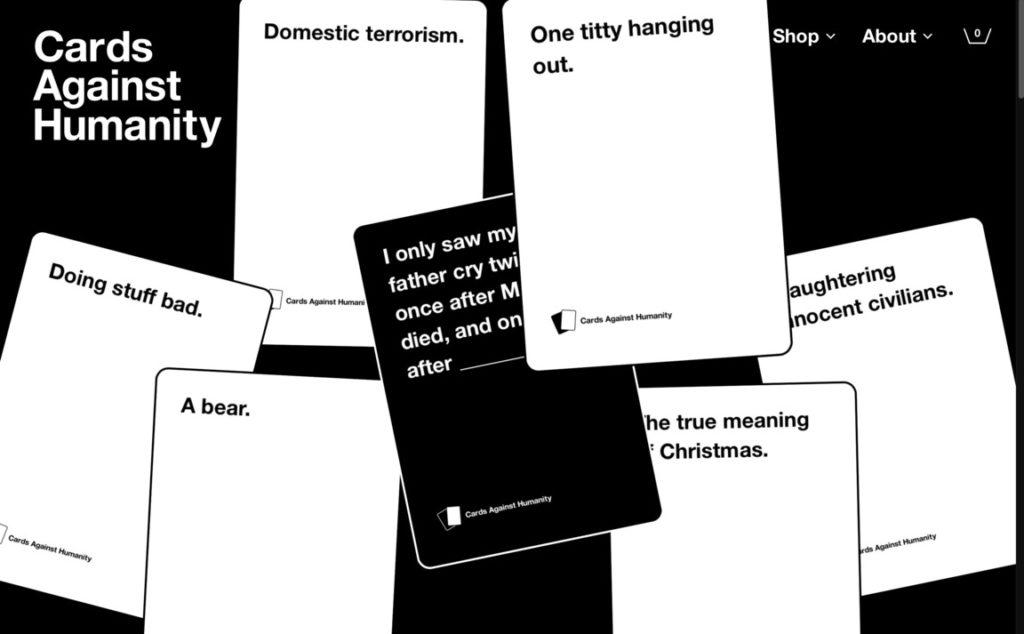The game I chose to play is perhaps the ever-more popular Cards Against Humanity. Created by 8 Highland Park High School alumni (Josh Dillion, et. al.) in 2011, Cards Against Humanity is, as the name suggests, a cards game that features offensive and politically incorrect humor, hence the latter part of the name. That in mind, there are many online versions/clones of the game for which I opted due to not being able to meet up with all of my friends in-person.
 Cards Against Humanity is a popular party game and so the target audience is really any group of people (strangers or otherwise) that like risqué humor and/or just love living on the edge. In this fellowship oriented game, players have one of two roles each round: a judge/Card Czar or a player that submits cards. The setup of the game is that each player draws 10 white cards and at the beginning one player is chosen at random as the Card Czar (which then rotates each round) who then draws a black card and places it for everyone to see. The first to get 5 points wins (although you can increase the points to be as high as 10 for a longer game)! That said, the fun of the game not only lies in seeing what others come up with and seeing everyone’s reactions but also in the creativity of combining cards that often include things you wouldn’t say out-loud with interesting prompts to create a narrative that would make anyone cackle (in a good way).
Cards Against Humanity is a popular party game and so the target audience is really any group of people (strangers or otherwise) that like risqué humor and/or just love living on the edge. In this fellowship oriented game, players have one of two roles each round: a judge/Card Czar or a player that submits cards. The setup of the game is that each player draws 10 white cards and at the beginning one player is chosen at random as the Card Czar (which then rotates each round) who then draws a black card and places it for everyone to see. The first to get 5 points wins (although you can increase the points to be as high as 10 for a longer game)! That said, the fun of the game not only lies in seeing what others come up with and seeing everyone’s reactions but also in the creativity of combining cards that often include things you wouldn’t say out-loud with interesting prompts to create a narrative that would make anyone cackle (in a good way).
An interesting aspect of the game lies in its boundaries and how it mixes both reality and the concept of the magic circle. For instance, the game includes many references to the real world and allows players to rely on changing dynamics and contexts that occur in the real world to make certain cards more funny. To see this more clearly, imagine a hypothetical round where the name Will Smith is played either as a part of a black card (prompt) or a white card (answer). The dynamics of the round and “how funny” it is will be incredibly different when played in the pre-oscars era and post-oscars era. It’s also important to note that while the entirety of a round might rely on the “outside” environment for relevancy, all of this occurs within the context of the game and is separate (enough) from the real world.
The game is inspired by Apples to Apples and so there are a lot of similarities in the mechanisms of the two games but what differentiates Cards Against Humanity has to be the theme of the cards, pertaining to the edgy and vulgar humor involved. Another subtle yet significant differentiator is the objective of the game. In Apples to Apples, for example, the czar picks the card they think describes the green card the best and so players need to play accordingly to something they think is described by that card. In Cards Against Humanity, however, the players need not necessarily play cards they think fit the prompt given but rather need to play a card they think the czar will find funny. This is an important distinction because different players will have different types of humor/things they find super funny and so your goal becomes to somewhat pander to czar’s taste.
This plays really well into how vulnerable people decide to be. If you do not wish to let others know what makes you laugh especially hard, you don’t have to (although it does make the game less fun in my humble opinion). If you’re an open book, great! Now everyone is going to play cards that will make you laugh. There is also the added personal element of knowing the other players/being friends with them and as such that also affects the degree to which you share things about yourself.


